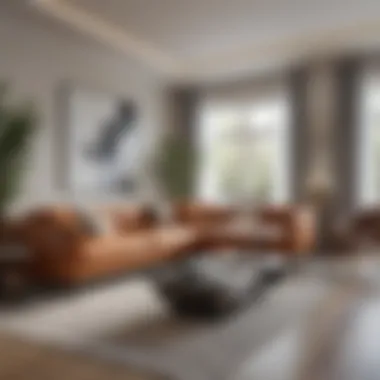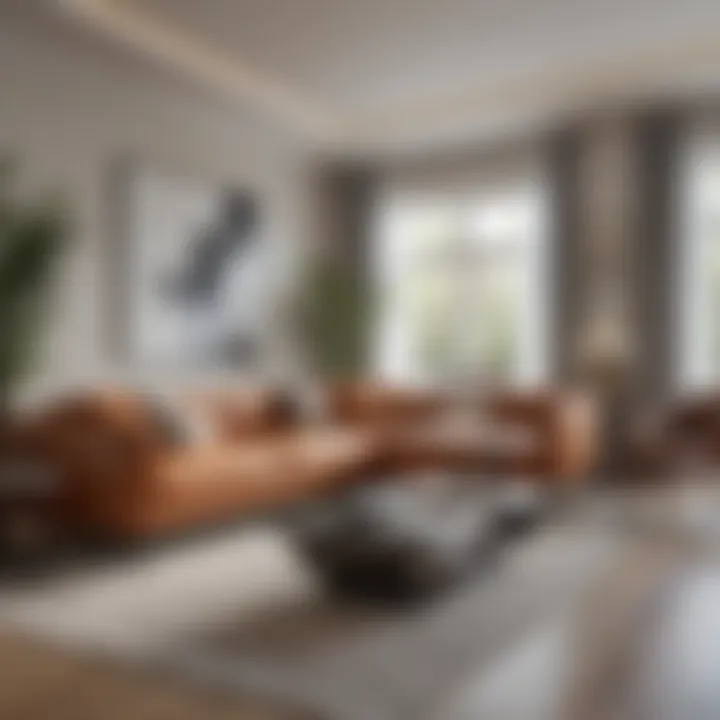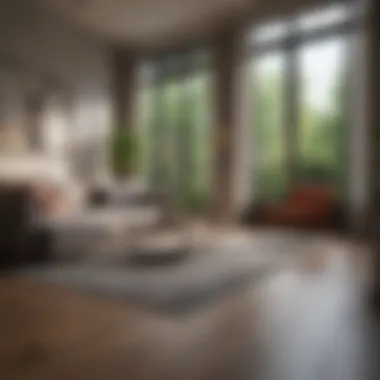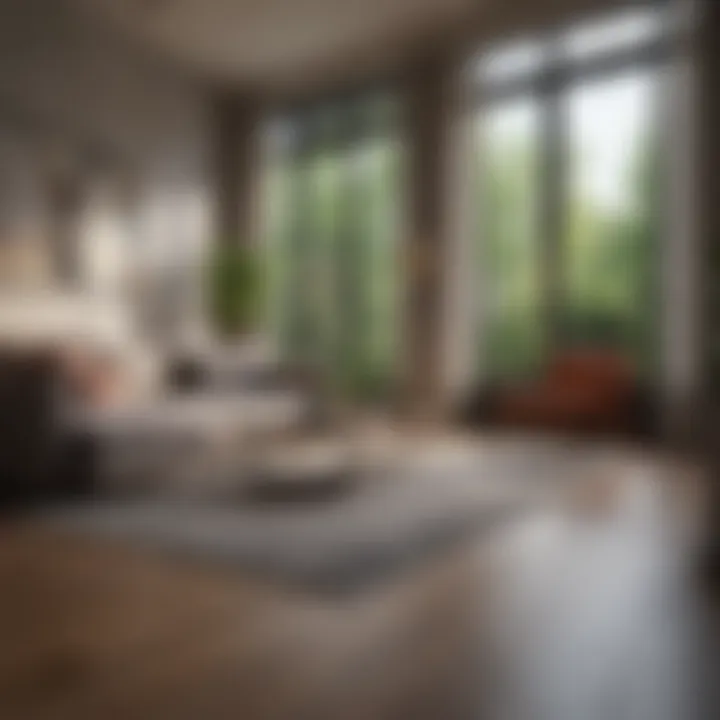Exploring One Floor Apartments: A Comprehensive Guide


Intro
One floor apartments have been making waves in the realm of residential living, captivating the hearts of many with their unique blend of convenience, aesthetics, and practicality. These dwellings embody a lifestyle where space and ease intertwine, resonating particularly with individuals and families seeking accessible, stylish, and community-oriented living.
In recent years, the shift towards single-level living has gained momentum, influenced by the increasing awareness of accessibility needs, especially as our populations age. It’s not just a trend; it’s a thoughtful response to the call for homes that cater to all members of society. With a little creativity and design finesse, these one-level abodes can become personal sanctuaries, accommodating everyone's needs without compromising on beauty or functionality.
This guide seeks to unravel the layers of one floor apartments, examining their architectural styles, showcasing innovative decor trends, and exploring stunning locations worldwide. We will also address the practical considerations involved in choosing this type of living arrangement. By the end, you’ll have a well-rounded understanding of why these homes are not just livable spaces but also lifestyle choices full of charm and potential.
Understanding One Floor Apartments
Understanding one floor apartments opens up a new realm of living arrangements that cater to various lifestyles and needs. These types of residences, often referred to as single-level homes, offer distinct benefits that align well with modern living preferences. Whether it’s due to mobility concerns, maintenance ease, or simply a desire for open space, one floor apartments present a compelling case for many homeowners and renters alike.
Several key elements define the worth of one floor apartments. First and foremost, the accessibility factor plays a crucial role. Unlike multi-level homes that can impose challenges, one floor units make movement straightforward for individuals of all ages and abilities. This is particularly valuable for families with young children or elderly members, where navigating stairs can sometimes be hazardous.
Moreover, the efficiency of space usage in these apartments often stands out. Without the need for stairways or hallways to connect different levels, every square foot is maximized. This leads to layouts that can be tailored to diverse lifestyles, whether you’re entertaining guests, working from home, or seeking tranquil nooks for relaxation.
In terms of maintenance, the simplicity of having everything on one level cannot be overstated. Cleaning becomes less of a chore, repairs are often more accessible, and outdoor spaces can cleverly extend the living area without the complexities of multi-level landscaping.
Overall, understanding the nuances of one floor apartments provides insight into why they have captured the interest of various demographic segments. The notion of single-level living is not just about convenience; it embodies a lifestyle choice that harmonizes practical living with personal preference.
Definition and Characteristics
One floor apartments are defined by their layout, which incorporates all necessary living spaces—such as bedrooms, bathrooms, kitchens, and living areas—on a single plane. There’s no need to ascend or descend stairs within the home, making mobility simple and stress-free.
They typically exhibit characteristics like:
- Open Floor Plans: Many one-floor apartments feature open concepts that create a seamless flow between rooms, enhancing the sense of space.
- Large Windows: These units often incorporate large windows to allow natural light to pour in, which contributes positively to the mood and ambiance.
- Outdoor Access: Direct interaction with outdoor spaces, whether it’s a patio or garden, is often a hallmark of one floor apartments. This design allows residents to easily transition between indoor and outdoor living.
When considering these elements, it’s important to recognize how they contribute to a broader appeal among various age groups and lifestyles.
Historical Context of Single-Level Living
To fully appreciate one floor apartments, it helps to look back at their historical evolution. Single-level living has roots stretching back to ancient civilizations, where practicality determined home designs. Early homes, particularly in rural settings, were predominantly one level to facilitate ease of access and maintenance.
As urbanization progressed, the demand for more housing led to the rise of multi-story buildings. However, certain cultural contexts maintained a preference for single-level structures, particularly in suburban America, where post-World War II housing booms saw a surge of ranch-style homes dotting the landscape.
In the late 20th century, focus shifted back towards accessibility and inclusive designs, prompting renewed interest in one floor apartments. Today, modern building practices emphasize open living spaces, and many architects are embracing this trend within urban developments.
With the growing need for adaptable living solutions, especially in light of an aging population, the significance of one floor apartments cannot be overlooked. They stand as a testament to how architecture can evolve to meet the diverse needs of humanity.
Advantages of One Floor Apartments
One floor apartments, often touted for their practicality and ease of living, hold significant appeal for various demographics. These residences make single-level living an enticing option, particularly for those prioritizing accessibility, maintenance simplicity, and efficient use of space. As societal trends lean towards more inclusive and adaptable living solutions, it becomes increasingly clear why exploring the benefits of one floor apartments is essential for both potential homeowners and investors alike.
Accessibility for All Ages
Accessibility is a primary advantage of one floor apartments. With no stairs to navigate, these residences are incredibly accommodating. This factor is often a game changer for individuals with mobility issues, seniors, or families with young children. Imagine a situation where an elderly parent visits. Instead of struggling with flights of stairs, they can move freely, contributing to a more relaxed atmosphere.
"Single-level living fosters independence and mobility across generations, making it a prime choice for multi-generational households."
One floor layouts naturally align with universal design principles, ensuring that spaces can be enjoyed by everyone. Features such as wider doorways and open floor plans facilitate effortless movement, reducing the risk of accidents and promoting safety. This design can be especially beneficial in emergency situations, where ease of evacuation becomes vital.
Easier Maintenance and Upkeep
Another clear benefit lies in maintenance. One floor apartments often require less time and effort to keep in good shape. There’s no need for labor-intensive stair cleaning or worrying about leaks from upper levels. All areas are within reach, simplifying regular chores such as dusting, vacuuming, and plumbing maintenance.
In terms of costs, maintenance expenses might be lower too. Homeowners can often save on utility bills, as climate control in a single-level space tends to be more efficient. No more struggling with varying temperatures on different floors. Since everything is consolidated, heating and cooling systems can work more effectively.


- More reachable locations for repairs
- Reduced physical strain during cleaning
- Lower utility costs due to better efficiency
Efficient Use of Space
The efficient use of space in one floor apartments can be striking. Unlike multi-level homes, which might waste space with hallways and stairs, single-level designs focus on maximizing the livable area. Every square foot counts, leading to clever layouts that cater to modern living needs.
Most often these apartments employ open concept layouts that encourage fluidity between spaces. When you walk into a one floor apartment, the sense of openness is palpable. This layout not only enhances natural light but also fosters social interactions. Additionally, many designs incorporate multi-functional areas that serve more than one purpose, like a living room doubling up as an office space.
Furthermore, outdoor space can also be seamlessly integrated into the design. Whether it’s a balcony or a small garden patio, having these areas accessible from a single level encourages relaxation and leisure right at your doorstep.
Design Considerations
When you step into the realm of one floor apartments, the design considerations play an essential role in maximizing both aesthetics and functionality. A well-thought-out design ensures that residents enjoy not just the physical space, but a seamless experience that enhances their lifestyle. In single-level living, where space can feel limited, every design choice is an opportunity to create something beautiful and efficient. This matters especially in urban environments where square footage comes at a premium.
Architectural Styles
Architectural styles for one floor apartments can vary as widely as the flavors in a bakery. Open layouts, modern lines, rustic touches, and traditional elements all have their unique appeal. For instance, a modern style often integrates large windows for natural light and sleek lines that provide a minimalist aesthetic. On the flip side, a rustic design might use wooden beams and stonework to bring warmth and coziness to the space. The right style not only reflects individual taste but also enhances liveability. The visual harmony between the apartment and its surroundings can provide a more profound connection to the community and environment.
Interior Layout Options
The interior layout options can pretty much make or break the feel of one floor apartments. You might find yourself dealing with the delightful dilemma of choosing between open concept living or more defined zones.
Open Concept Living
Open concept living has gained traction in recent years, bringing a breath of fresh air into traditional floor plans. This layout merges the kitchen, dining, and living areas, resulting in an airy and spacious atmosphere. A key characteristic of open concept living is the lack of barriers between rooms. This layout can be especially beneficial for families and individuals who enjoy entertaining.
The unique feature here is the way it fosters interaction. Cooking can become a communal activity rather than a solitary one. However, some may argue that the absence of walls can lead to noise distractions; with a lively gathering, it may not be the best choice for someone seeking quiet reflection.
Zoned Areas for Functionality
On the flip side, we have zoned areas that prioritize functionality. This approach creates distinct spaces, allowing for specific activities in designated areas. For instance, a quiet reading nook can reside far from the bustling kitchen.
The key characteristic here is the organization it offers. Such separation can reduce distractions significantly, catering to those who value peace while studying or working. The unique feature of this layout is that it can keep chaos at bay during busy times. However, it does require more attention to design so that each zone flows well together; otherwise, it can feel disjointed.
Privacy Considerations
Privacy considerations are vital in one floor apartments, especially for families or individuals sharing their spaces. This aspect can be one of the most significant factors in choosing layouts. A home designed with private areas—like a separate master suite away from common spaces—can create a sense of sanctuary.
The key characteristic here is delineation. Good design can ensure that bedrooms feel separate from living areas, contributing to overall comfort. The unique feature of fostering privacy without walls means using clever furniture placement and room dividers. Unfort u nately, depending on the overall size, a lack of defined spaces can leave some feeling like they’re living in the same room all the time.
Incorporating Outdoor Spaces
When incorporating outdoor spaces into one floor apartments, it’s essential to blur the lines between inside and outside. Balconies, patios, or gardens can significantly enhance the experience of living in smaller spaces. This aspect creates a sanctuary where residents can unwind amidst nature, providing a perfect setting for enjoying morning coffee or evening conversations.
Integrating these outdoor areas can elevate the value of a single-level living option, making it a coveted choice for potential buyers and renters.
"The perfect blend of indoor and outdoor spaces can turn an apartment into a sanctuary, providing a breath of fresh air and a sanctuary of peace"
By thoughtfully designing one floor apartments, the intricacies of these choices can manifest in a space that is functional, beautiful, and uniquely personal.
Personalization and Decor
When it comes to making a house a home, personalization and decor play a pivotal role. One floor apartments present unique opportunities for residents to express their individuality and style through thoughtful design choices. Unlike multi-level homes, the layout and aesthetics of a single-level space can be more straightforward to navigate when it comes to decorating and personalizing. Moreover, customization adds a layer of comfort and presence, making the living space not just functional but also visually appealing.
Creating Cozy Ambiances
Creating a cozy atmosphere is essential in one floor apartments where the flow between spaces can be seamlessly maintained. Using soft furnishings, like plush throws and cushions, can invite warmth and a sense of comfort. Natural elements, such as wooden accents and indoor plants, tend to soften the overall look while also purifying the air. Consider using layered lighting—like table lamps, floor lamps, and even candles—to create a welcoming glow that feels both intimate and relaxing.


A versatile layout allows you to rearrange furniture easily to create nooks for reading or socializing. Adding personal touches, like framed photographs or artwork, can evoke fond memories and emotional resonances. An effective way to prompt coziness is by introducing cozy corners filled with comfortable seating, such as a large armchair or a small sofa that beckons a good book or conversation over coffee.
Utilizing Color Schemes Effectively
Color plays a significant role in setting the mood of any space. For one floor apartments, the choice of a color palette can unify different areas, making the apartment feel cohesive. Soft, muted colors like pastels can make a space feel airy and more expansive. Conversely, richer tones can add depth and drama.
To enhance the cozy vibe, consider warm neutrals or earthy tones which can create a calming atmosphere. It’s also commendable to think about natural light; warm shades can reflect sunlight beautifully, enhancing the overall ambiance.
Also, don’t shy away from integrating an accent wall or even a bold piece of artwork that can catch the eye and serve as a conversation starter. Using consistent colors across different rooms – while adding variations, of course – can draw the entire living area together.
Furniture Selection and Layout
Choosing the right furniture is fundamental to making the most out of the available space in one floor apartments. Opt for pieces that maximize functionality without sacrificing style. Multi-functional furniture, like storage ottomans or foldable dining tables, can help you avoid clutter and maintain an inviting appearance.
When planning the layout, consider open concept designs that promote ease of movement and broad sightlines. You could use rugs to define separate spaces within the apartment, allowing for a flow that feels inviting and organized.
Appropriate scale is key; oversized furniture can make a small space feel cramped, while too small pieces might feel lost. Aim for a balance where the size of your furniture relates well to the space available. Also, strategically placing mirrors can create an illusion of depth and make rooms feel larger than they actually are.
"A home isn’t just a place to live; it’s a canvas for your individuality."
In short, personalizing your one floor apartment through decor not only enhances aesthetics but also fosters a sense of belonging. Thoughtful design choices enable residents to create inviting spaces that reflect their personality. This interplay between comfort and style is what truly transforms an apartment into a home.
One Floor Apartments Around the World
One floor apartments hold a distinct place in residential design across diverse cultures and settings. Their significance isn't solely about minimizing stairs; it's about how these spaces harmonize with lifestyle preferences and regional needs. Around the globe, one floor living reflects unique architectural traditions and solves practical living challenges. By exploring examples from various regions, we can appreciate the flexibility and relevance of single-level homes in today’s housing market.
Case Studies from Urban Environments
In urban centers where space is often at a premium, one floor apartments offer a practical solution without sacrificing accessibility. Take, for instance, the case of Melbourne, Australia. The city has embraced the concept of single-level living in densely populated areas. Many developers are creating stylish studio apartments that maximize smaller plots while maintaining an open feel. These units are particularly appealing to millennials who appreciate minimalist living and proximity to city amenities.
Another apt example can be found in Tokyo, Japan. The city’s architecture effectively utilizes small land parcels. One floor apartments here often feature clever designs that incorporate sliding doors, transforming spaces as needed. A standout project is the "Muji House," a sleek, one-story dwelling that emphasizes functionality and simplicity, harmonizing with urban life yet offering a cozy retreat from bustling streets.
Rural Inspirations for Single Level Homes
In contrast to urban examples, rural settings present a different take on one floor apartments. Here, the emphasis often leans toward the integration of nature and spacious layouts. In the scenic landscapes of Tuscany, Italy, single-level homes are typically adorned with exposed beams and natural stone. This design not only reflects local architectural heritage but also provides a harmonious balance with the rolling hills and vineyards that define the region.
Further afield, in the expansive plains of Montana, USA, single-level ranch-style homes are the norm. These sprawling properties are ideal for families who desire connection with the outdoors and ample space for activities. The benefits of living in such homes include ease in achieving a rugged charm while maintaining functional living areas. Residents often find that the simplicity of single-level living aligns well with their lifestyle choices, as it promotes community interaction and a laid-back atmosphere.
Single-level living not only simplifies the dynamics of space but also fosters a sense of community and ease, making it an attractive choice in various settings.
In summary, one floor apartments across the globe reveal a tapestry of styles and characteristics that cater to different lifestyles. From bustling urban environments to serene rural landscapes, single-level living offers unique benefits that resonate with the needs of today’s residents.
Economic and Environmental Impact
The discussion around one floor apartments can't ignore the interplay of economic and environmental factors. As urban populations swell and land prices surge, these types of residences emerge as a practical solution to provide affordable housing without compromising on livability. One floor apartments often present opportunities for developers and homeowners alike. Here, understanding the economic benefits and the environmental sustainability that these living spaces can offer is crucial.
Cost Advantages of Fewer Levels
Living in a single-level setup generally means lower construction and maintenance costs. Without the need for staircases or multiple floors, homeowners can often save a bundle during the build process. This becomes even more significant when considering the expenses associated with building codes, insulation, and heating.
Also, the upkeep costs tend to follow suit. Less square footage often means easier cleaning, less wear and tear, and fewer repairs. Homeowners will appreciate the simpler tasks of maintaining one level rather than juggling higher ceilings or larger areas that need different considerations. For instance, replacing a roof or cleaning gutters can be particularly burdensome in multi-level homes, but with a one floor plan, these tasks can be streamlined.
To sum it up, consider the following benefits when it comes to cost advantages in these living arrangements:
- Lower Construction Costs: Fewer materials and a simpler design can save a pretty penny.
- Reduced Maintenance Expenses: With less area to care for, costs stay manageable over time.
- Energy Efficiency: Less space to heat or cool means lower monthly utility bills.
Sustainability Considerations


The push for sustainability has permeated every aspect of our lives and housing is no exception. One floor apartments generally present a more environmentally friendly option due to their smaller footprint. Not only do they use fewer resources in both the construction and maintenance phases, but they also lend themselves to better energy efficiency. Enhanced insulation and more strategic design can lead to lower energy consumption, which is a win-win for both the environment and your wallet.
Additionally, these apartment types can encourage community-oriented living. Since they are often designed in clusters or communities, they can lead to a reduced reliance on personal vehicles. With a smaller scale of development, residents can access amenities with ease—whether it be walking to work or heading to a local market. This reduction in transport not only lessens traffic but also reduces greenhouse gas emissions. In practical terms, choosing a one floor apartment can directly support the fight against climate change.
Aspects of sustainability connected to one floor living include:
- Reduced Resource Usage: A smaller footprint often means less waste and fewer materials.
- Increased Energy Efficiency: Cost-effective solutions translate to lower energy bills and reduced carbon footprint.
- Community Connectivity: Encouraging walking reduces reliance on cars, contributing to cleaner air around neighborhoods.
"The future of our living spaces must be as much about sustainability as it is about comfort and convenience. One floor apartments embody this spirit, respecting our environment while serving our everyday needs."
By embracing the advantages that one floor apartments afford us, we can forge pathways towards both economic viability and environmental sustainability.
Challenges and Considerations
When considering one floor apartments, it’s vital to delve into potential challenges and considerations associated with this style of living. While single-level homes offer an array of benefits, such as accessibility and ease of maintenance, they also come with certain limitations that might not be evident at first glance. In this section, we will take a closer look at these aspects and provide insights that can help future residents make informed decisions.
Potential Limitations of Single-Level Living
One major limitation that often arises with one floor apartments is the lack of vertical space. In densely populated urban areas, where land can be scarce, developers frequently opt for high-rise buildings. Consequently, this can restrict the number of available single-level units, making them harder to find. Additionally, those who prefer a yard or outdoor space might feel cramped in a single-level apartment, particularly if balconies or patios are not included.
There’s also the matter of privacy. Living on a single floor can mean that units are closer together compared to multi-story buildings. This proximity might lead to potential noise issues. Sounds from neighbors can permeate more easily, and residents may feel their activities are less private.
Moreover, some might argue that single-level living can sometimes feel less impressive from an architectural standpoint. The lack of height may limit dramatic views or unique structural designs that multi-level homes can offer. The aesthetic appeal of elevated spaces in cityscapes can be somewhat diminished. Still, many people argue it's about one’s personal preferences.
Adapting to Changing Life Stages
Life is an ongoing journey, and one’s living needs can evolve dramatically over time. Because of this, selecting a one floor apartment might require extra consideration and foresight. For instance, a young couple might find a single-level unit perfect for their first home. It’s easy to maintain and manage, fostering a simpler lifestyle. However, as they grow their family, their needs might change, and the limitations of space could become evident.
As children grow up, their requirements for personal space, additional rooms, and possibly even outdoor play areas heighten. What was once a cozy space can become insufficient as family dynamics shift. Therefore, potential residents ought to think ahead. It might be beneficial to contemplate how adaptable a one floor apartment is for future life stages, particularly if you don’t plan to move frequently.
One option could be exploring designs that offer flexible spaces, such as rooms with convertible layouts or those that can serve multiple functions. There’s also the idea of choosing a location that allows easy transitions to other types of accommodation if necessary.
"Choosing the right home is more than just about aesthetics; it's about anticipating the future needs."
By contemplating these factors, you will be in a better position to enjoy a satisfying and appropriate living arrangement.
The Future of One Floor Apartments
As urban landscapes evolve and lifestyles shift, the significance of one floor apartments continues to grow. These single-level living spaces are becoming a cornerstone in the trend toward more accessible, sustainable, and adaptable housing solutions. The future of one floor apartments encompasses various aspects ranging from architectural innovation to the socio-economic factors influencing their popularity.
In the context of this article, acknowledging the future of one floor apartments is crucial. It focuses not only on design trends but also on how these spaces can harmonize with modern living demands. With populations growing and urban areas expanding, understanding the trajectory of these housing options helps prospective buyers and designers alike.
Trends in Architectural Design
The architectural landscape is witnessing gradual yet profound changes aimed at enhancing the appeal and functionality of one floor apartments. One noteworthy trend is the integration of passive design principles, which involve utilizing natural light and thermal mass to cut down energy consumption. Homes designed in such a manner are not just a pretty face; they save on utilities and contribute to the environment—a win-win!
Among the latest architectural styles gaining traction, the minimalist approach is particularly notable. Think clean lines, open spaces, and a focus on functionality rather than frivolity. It’s about embracing simplicity while maximizing the use of available area. Combined with green roofs and outdoor spaces, these design choices provide a holistic living experience, blending indoors with nature.
Some key features of future architectural designs for one floor apartments include:
- Sustainability: Eco-friendly materials and methods are in vogue. From bamboo flooring to solar panels, many apartments are getting greener and cleaner.
- Smart Home Integration: With technology seeping into every aspect of life, applying smart technology to streamline processes is becoming commonplace. Think automated lighting systems, advanced security features, and even smart thermostats that adjust to your lifestyle patterns.
- Flexible Spaces: As life changes, so does the need for space. By designing apartments that allow for easy modification, residents can transform a guest room into a home office or a play area as needed, making the living area truly multi-functional.
As these trends continue to develop, they are likely to redefine what one floor apartments can offer, making them desirable dwellings among varied demographics.
Impact of Urbanization on Single-Level Housing
Urbanization is reshaping modern living, and one floor apartments are not immune to its effects. As cities grow and more people flock to urban centers, the demand for efficient and accessible housing becomes crucial. One floor apartments meet these demands, offering a practical alternative to more traditional multi-level homes.
The impact of urbanization can be categorized into several areas:
- Affordability: As housing costs soar in urban areas, single-level living is often more budget-friendly compared to towering condos or multi-story houses. It allows families to enjoy space without breaking the bank.
- Community and Connectivity: Many developers are focusing on creating neighborhoods that foster community interaction. One floor apartments often facilitate this aspect, especially when they’re designed with communal gardens or shared spaces.
- Mobility and Inclusiveness: One floor apartments offer easier access for individuals of varying abilities. With aging populations and the increasing need for inclusive design, single-level living is a step toward equality in housing.
"The design of our living spaces directly affects our quality of life, and one floor apartments stand as a testament to that principle."
All in all, as urbanization intensifies, one floor apartments are poised to become a more critical component of the housing sector. They reflect the need for adaptability and inclusivity, making them not just homes, but essential parts of a future city landscape.







